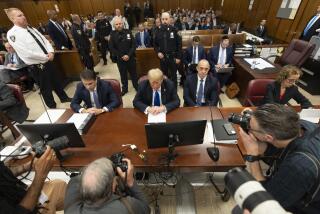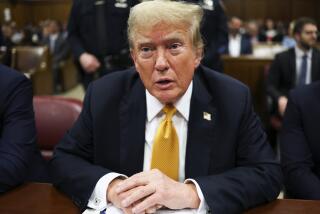Check From Dominelli Was Key to Jury’s Guilty Verdict : Every Bit of Evidence Analyzed During Lengthy Deliberations
- Share via
The jury that found Mayor Roger Hedgecock guilty of felony conspiracy and perjury was determined not to have its more than 60 hours of sequestered deliberations end in a deadlock, jury foreman Richard Stark said in an interview Wednesday evening.
“We were not going to have a hung jury,” said Stark, who repeatedly referred to the fact that one hold-out juror had blocked a conviction in the mayor’s first trial. “We didn’t want that.”
For the record:
12:00 a.m. Oct. 11, 1985 For the Record
Los Angeles Times Friday October 11, 1985 San Diego County Edition Part 1 Page 2 Column 1 Metro Desk 1 inches; 27 words Type of Material: Correction
The caption under a picture in Thursday’s edition of The Times incorrectly identified a juror in the trial of San Diego Mayor Roger Hedgecock. The juror identified as Karon Dyer was Marian Pierce.
At least two jurors believed as late as Sunday night--four days into their deliberations at the Hanalei Hotel in Mission Valley--that Hedgecock had not conspired with political backers to illegally funnel money into his 1983 campaign for mayor. But Stark said those jurors changed their minds after meticulously reviewing the stacks of evidence and the testimony of the trial’s 61 witnesses.
Key to their decision was a $3,000 check written to Hedgecock by now-bankrupt financial swindler J. David (Jerry) Dominelli in December, 1981, a transaction Stark termed “the tip of the iceberg.”
Once the jury agreed Tuesday night to unanimously find Hedgecock guilty of conspiracy, several of the jurors broke down and cried at what they were about to do.
“It was an emotional time for all of us: We had the mayor of San Diego, it was a white-collar crime,” Stark said. “After all, we’re all human. Nobody wanted to believe all this stuff . . . . The evidence was there.”
Although Hedgecock’s decision not to testify apparently did not play a critical role in the jury’s decision, Stark said he would have liked to have heard Hedgecock explain why he resumed his friendship with Hoover.
“I think I’d have had Hedgecock get up in that one area and unravel the beginning of this thing if he could,” Stark said. He added that it might have helped the defense if Hedgecock had testified about “what he’s done, how he’s handled San Diego, what he’s done for us.”
Stark was the only juror who would talk in depth to The Times about the jury’s deliberations. The others--many of whom appeared drained by their ordeal--either spoke briefly or declined to talk at all.
“It was a painful experience,” juror Karon Dyer, 46, of La Mesa said. “It was nothing anyone enjoyed, but we did our job.”
Betty Jo Crabb, a Spring Valley housewife, was still showing signs of fatigue when she was reached at her home three hours after the verdict was announced.
“I am emotionally exhausted,” she told a reporter at her door. “I just want to rest.”
Bryce Bulman, the jury’s youngest member at 20, referred all questions to Stark. He wouldn’t say why the jurors were reluctant to discuss their experience.
“We all have our reasons,” he said. “I have mine.”
A male voice recorded on the answering machine at Marian Pierce’s house said: “The answer is no. I don’t know what the jury has come out with yet. If you’re from the press, absolutely no comment. But if you’re anyone else, please leave . . . a message and . . . Marian will get back to you when the jury is through sequestering.”
The jurors looked grim as they filed into the third-floor courtroom at 1:32 p.m. From their seats in three rows, they peered into their laps and glanced at each other, avoiding Hedgecock’s eyes as he sat with his hands folded at a table a few feet away.
The courtroom grew deathly silent while Judge William L. Todd Jr. shuffled through a pile of forms spelling out the charges and the jury’s verdict on each of the 16 counts.
Then Todd handed the papers to his clerk, Mary Rademaker, and she read each aloud, revealing what most of the courtroom audience had already sensed. Hedgecock was found guilty of felony conspiracy and 12 counts of perjury. He was acquitted on two perjury counts and a misdemeanor conflict of interest charge.
At that point, several of the jurors who had been fighting back tears gave way. Kathy Saxton-Calderwood, a San Diego State University student, sobbed as she sipped water from a small paper cup given to her by a bailiff.
Defense attorney Oscar Goodman’s request to have the jury polled on each count prolonged the discomfort. As the clerk questioned them 16 times to confirm the accuracy of the printed verdicts, each juror repeated “Yes,” though some of their answers were so faint that they could barely be heard.
After the jury was dismissed, the members gathered in a room behind the court. They left the courthouse one by one, ushered through a mob of reporters by marshals and family members who had come to pick them up. When several jurors left together to be driven home in a county van, they appeared jubilant at having escaped the media.
Later, outside his house on a quiet cul-de-sac in University City, Stark recalled the jurors’ laborious and monkish eight days--their initial indecision, their meticulous reviewing of evidence, and their final, emotional, unanimous votes.
Stark said the jury began deliberations every morning at 7:30 in a conference room next to their rooms. They would work through breakfast, break at 12:30 for lunch, return around 3 p.m., break for dinner, and then work into the night.
On Friday, they worked until 11 p.m., Stark said. Saturday was a 16-hour day. The only break from the routine was one walk around the parking lot, en masse. No more walks were permitted, Stark said, after one juror nearly got lost.
Assigned to rooms in twos, they could never leave alone. No one could go alone into the conference room, where the evidence was kept. Televisions and radios had been removed from the bedrooms. Stark passed spare time on his balcony reading the judge’s instructions.
They would eat in the hotel dining room by themselves, when no one else was eating, Stark said. The case was never discussed at meals. Instead, the jurors talked about children, families, and what they would do when they “got out.”
The three alternate jurors were isolated down the hall and ate apart from the other jurors. One alternate, Dennis Suchecki, said he and the other two did a lot of reading. He said they prayed together, to give the other jurors “spiritual guidance.”
There were roles for jurors with particular expertise, Stark said.
Dolores Pickering, a former court reporter for the Navy, explained court procedure to other jurors. Dyer, project manager for a computer systems house, helped explain accounting, and Stark, a bank vice president, deciphered checks and deposit slips.
Stark said every witness was discussed, every piece of evidence studied.
Ann Rogers and Marian Pierce prepared a giant calendar, then logged each event in chronological order to help the jurors keep track. A piece of “meat paper” bore the names of each witness. Each juror would take a witness and discuss what he or she had said.
“That’s the point where someone would say, ‘I didn’t believe that person,’ ” Stark said, recalling how each juror went back over his or her notes. “And I’d say, ‘Well, you may discredit that individual, but you have to consider the evidence.’ ”
The first straw vote came Sunday evening--the jurors standing around the table and raising their hands, Stark said. When the vote on the conspiracy count was divided, they moved on to the second count, which charged that Hedgecock had falsified a campaign finance statement covering the last half of 1981. The vote on that one was unanimous for acquittal.
During the following days, Stark said, the jury left the troublesome conspiracy count alone and went through the others, count by count. When the initial straw votes on some were split, the jurors would stop and discuss their reservations.
“I would yell it out, ‘Unanimous’ or ‘Not unanimous,’ ” Stark said. “Then we would go and say, ‘What’s your problem, Mary?’ ”
Ironically, the jurors placed little credence in the testimony of Sorrento Valley investment counselor Harvey Schuster, who provided the only direct evidence linking Hedgecock to alleged co-conspirators Nancy Hoover, Tom Shepard and Dominelli. The jury found Hedgecock not guilty of a misdemeanor conflict of interest charge stemming from Hedgecock’s vote on a county project on which Schuster bid. The vote occurred only months after the investment counselor had paid a $500 legal bill for the then-county supervisor.
“I’m not sure Mr. Hedgecock really knew about the bill,” Stark said. “I thought it was professional courtesy type of thing.”
About 5:30 p.m. Tuesday, just before dinner, Stark called for a second straw vote on the conspiracy count. Having spent the last two days going through each of other charges, the vote for guilty on the conspiracy count was unanimous.
“There was a lot of emotion about it, some sniffling,” Stark said. For a while, the jurors sat in silence around the table, looking at their laps.
Contributing to this story were Times staff writers Armando Acuna, Glenn F. Bunting, H.G. Reza and Jim Schachter.
More to Read
Sign up for Essential California
The most important California stories and recommendations in your inbox every morning.
You may occasionally receive promotional content from the Los Angeles Times.













